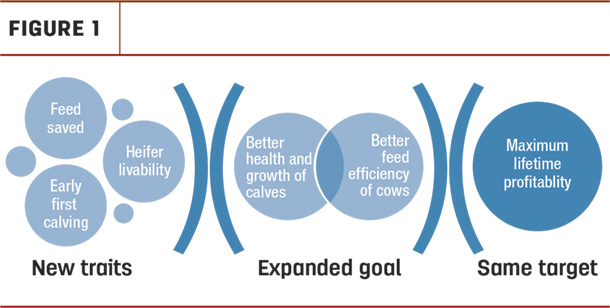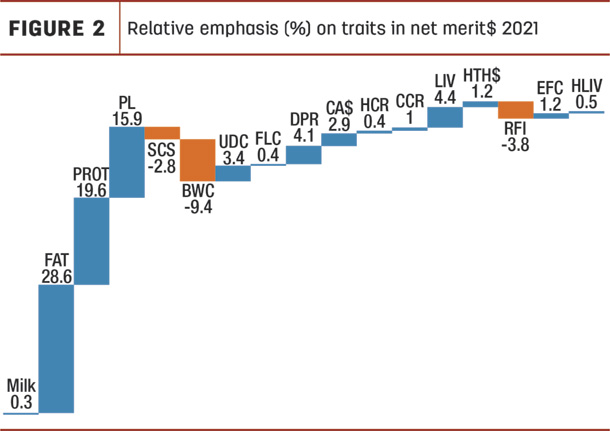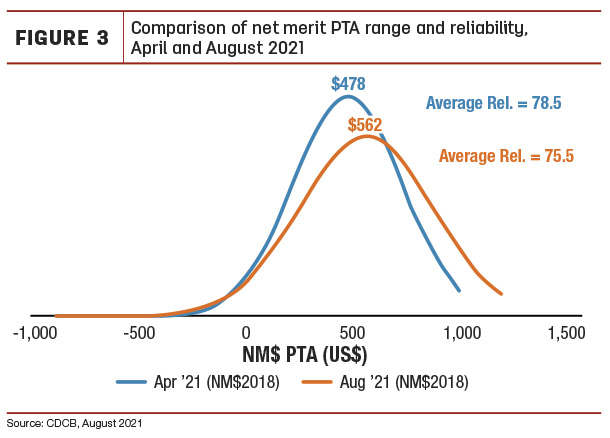The national genetic index, Net Merit, was updated with the genetic evaluations on Aug. 10, 2021 – delivering an improved tool to breed profitable and feed-efficient cows.
This 2021 revision of Net Merit is quite significant, with three new traits and important revisions to economic weights.
What has not changed is the main objective. Since its introduction in 1994, Net Merit has been designed to select for a balance of traits that maximize cow profitability, based on the available information. We want the next generations of cows to be healthier, longer-living, more resilient, more efficient and ultimately more profitable than the current generation.
Here, I’ll answer the most common questions about the new Net Merit.
What is Net Merit?
Net Merit estimates how much lifetime profit each animal is expected to transmit to its progeny. Selection indices like Net Merit drive genetic progress and combine information on many traits into a single value for producers to rank animals and make breeding and culling decisions. Net Merit now incorporates more than 40 traits, some individually and some through composites (i.e., Calving Ability, Health Dollars, Udder, Feet and Legs, and Body Weight Composite).
What new traits were added?
Three traits – Feed Saved, Early First Calving and Heifer Livability – are now in Net Merit (Figure 1).

The incorporation of feed efficiency has received the most attention because feed costs are one of the key profit drivers. Strengthening the emphasis on health and growth of calves is also an advancement.
What emphasis is placed on the new traits?
Net Merit now includes the two components of Feed Saved: Residual Feed Intake (RFI) with a relative emphasis of -3.8% and Body Weight Composite (BWC) with -9.4%. RFI is the difference between the actual and expected feed intake of a cow.
Early First Calving (EFC) and Heifer Livability (HLIV) receive a relative emphasis in Net Merit of 1.2% and 0.5%, respectively.
How are the weights for other traits affected?
Generally, when traits are added to an index, the emphasis of previously included traits is proportionally reduced, even if their economic importance remains the same. This is the case in Net Merit 2021 for most traits, such as Milk, Protein, Somatic Cell Score (SCS), Daughter Pregnancy Rate (DPR), Heifer and Cow Conception Rate (HCR, CCR) and Health (HTH$).
The 2021 Net Merit places more emphasis toward longer Productive Life (PL) and smaller Body Weight Composite (BWC), based on new information about economic impacts.
Figure 2 shows the relative emphasis given to each trait and composite in the 2021 formula, expressing traits we select for (positive weights) in blue and traits we select against (negative weights) in orange.

Relative emphasis is now used instead of relative value. Relative emphasis considers that traits have different reliabilities and ranges of genetic variation, which is beneficial when adding traits of high economic importance and lower reliability, such as Feed Saved and Residual Feed Intake (RFI).
Why are we selecting for smaller cows?
Dairy cows range between 900 and 1,600 pounds. We know maintenance costs are higher for the larger animals. About one-third of the total feed cost goes toward keeping a cow healthy and two-thirds toward supporting milk production. Feed requirements for maintenance had not been examined for decades. The recent research that allows us to measure and calculate genetic evaluations for feed efficiency also showed that maintenance costs were previously underestimated.
Because maintenance costs are proportional to body size, a high negative emphasis is placed on Body Weight Composite. If two cows produce the same milk yield but differ in body size, the smaller cow is considered more efficient due to lower maintenance needs.
How does the new Net Merit correlate with the previous formula?
There is a high correlation (98.1%) between the previous (2018) and new (2021) Net Merit formulas.
It seems there are higher numbers for Net Merit in August. Is that the case?
There is an increase in the variation of Predicted Transmitting Abilities (PTAs) for Net Merit. That is reflected by an increased range of PTAs for all animals – both male and female.
Figure 3 shows the distribution of PTAs for A.I. bulls, comparing the Net Merit formulas from 2018 (blue) and 2021 (orange).

NM$ 2021 has a wider distribution – or larger variance – and a higher mean PTA of $562, compared with the mean of $478 with the 2018 formula. The inclusion of RFI, a trait with lower reliability, resulted in the decrease of average reliability from 78.5% to 75.5% among the approximately 7,000 A.I. bulls in this dataset.
For more detail, please check Council on Dairy Cattle Breeding for an in-depth Q&A prepared by the CDCB team and collaborating geneticists at the USDA Animal Genomics and Improvement Laboratory.
The bottom line
Since 1994, Net Merit has been based on the best available research to provide unbiased estimates of expected lifetime profit from dairy animals. The 2021 update incorporates newer traits of significant economic importance and revises previous assumptions for maintenance costs and other factors. For most dairy producers, using an index like Net Merit – which accounts all important traits combined – is the best way to maximize herd profitability through genetic improvement.





